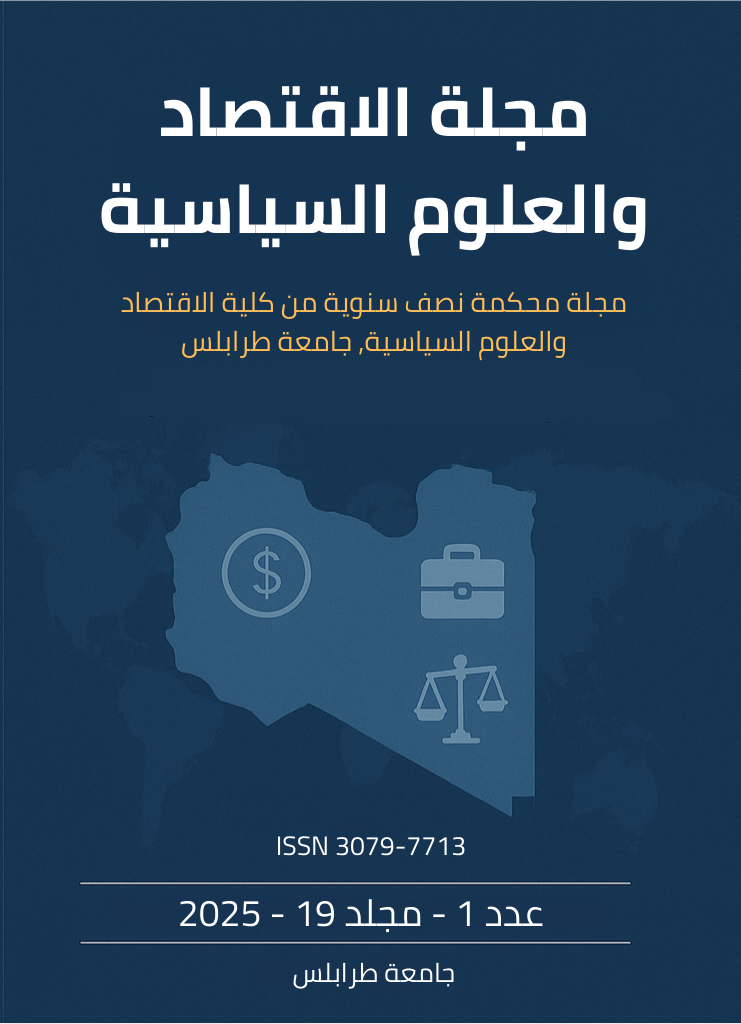ال أثر عدم الاستقرار الأمني على تقلبات سعر صرف العملة المحلية ومحاكاتها بالسوقين الرسمي والسوداء
الكلمات المفتاحية:
السوق السوداء، العملة المحلية، لاستقرار الأمني، الاقتصاد الليبي، سعر الصرف الرسميالملخص
هدفت الدراسة للكشف عن تأثير الجانب الأمني على أذكاء تدهور قيمة العملة المحلية، ومن ثم التنبؤ بسعر صرفها بالسوقين الرسمي والسوداء. واعتمدت منهجية الدراسة على أسلوب التكامل المشترك لـ "Johansen" لتقدير دالة الدراسة بالمدى الطويل و"VECM" لتقديرها بالمدى القصير، ولفترة يومية امتدت من يناير 2018 وحتى أغسطس 2024، كما اعتمدت الدراسة على منهجية التمهيد الآسي الثلاثي (DES, ESE, H-W -no seasonality, H-W Additive Seasonal, H-W Multiplicative Seasonal)، للتنبؤ بالفترة الممتدة من منتصف أغسطس 2024 وحتى منتصف أغسطس 2025, وتوصلت إلى أن عدم الاستقرار الأمني "D2" الناجم عن الصراعات يؤثر على قيمة الدينار الليبي بالمدى الطويل. وأن عدم الاستقرار الأمني "D3" الناجم عن الخطف والرهائن، له أثر عكسي على قيمة العملة المحلية بالمدى الطويل. وأن قيمة العملة المحلية ستستمر بالتدهور في السوق الرسمي لتبلغ في أغسطس 2025 نحو 6.9 د. ل للدولار، وبالسوق السوداء إلى نحو 8.50 د. ل للدولار مطلع أغسطس 2025.

التنزيلات
منشور
كيفية الاقتباس
إصدار
القسم
الرخصة
الحقوق الفكرية (c) 2025 مجلة الاقتصاد والعلوم السياسية

هذا العمل مرخص بموجب Creative Commons Attribution 4.0 International License.
1- يقدم الباحث تعهداً ( حسب النموذج المعد لذلك ) يفيد بأن الإنتاج العلمي المقدم لغرض النشر في المجلة لم يسبق نشره بأي صورة ، وأنه غير مقدم للنشر لأي جهة أخرى ،وأنه ليس ملخصاً لأي إنتاج علمي سبق نشره .
2- يخضع كل الإنتاج العلمي المقدم لغرض النشر في المجلة لبرنامج (Software) معتمد لغرض الكشف عن أية مخالفات لقوانين الملكية الفكرية ( السرقة الأدبية ) ( PLAGIARISM) للتأكد من أمانته العلمية .
3- في حالة ثبوت أية مخالفات لقوانين الملكية الفكرية يمنع الإنتاج العلمي من النشر في المجلة بشكل نهائي.
4- يقدم الإنتاج العلمي في ثلاثة نسخ ورقية (Hardcopy) على مقاس ( A4 ) ، بالإضافة إلى نسخة واحدة على قرص مدمج ( CD ) مكتوباً ببرنامج ( Word ) تحت نظام التشغيل ( Windows).
5- لهيئة التحرير حق الفحص المبدئي للإنتاج العلمي المقدم للنشر وتقرير أهليته للتحكيم أو رفضه .
6- لهيئة التحرير حق طلب أي مستندات تراها ضرورية لإتمام عملية الفحص المبدئي أو التحكيم ، على سبيل المثال لأ الحصر : ( نماذج تحليل البيانات الإحصائية – صحائف الاستبانة المملؤة من قبل المستجوبين – التقارير .. الخ )
7- تعبئة نموذج التعارف الخاص بالمجلة الذي يحتوي على بعض البيانات الضرورية للاتصال بالباحث .
8-تكون فترة استلام الإنتاج العلمي من قبل الباحثين حسب المدة المذكورة في إعلان فتح قبول الإنتاج العلمي للنشر في المجلة .
9- يتم استلام الإنتاج لغرض نشره في المجلة عن طريق اليد أو عن طريق البريد الالكتروني للمجلة .
10-تعطي الأولوية في النشر للإنتاج العلمي التطبيقي ( العملي ) ، كما تعطي الأولوية أيضا للإنتاج العملي الذي يعالج مشاكل قائمة تمس ليبيا .
11 –يخضع ترتيب الإنتاج العلمي للنشر في المجلة تبعاً لاعتبارات فنية تحدد من قبل هيئة التحرير .
12 – كل الآراء الواردة في الإنتاج العلمي تعبر عن أصحابها فقط ، ولا تعبر بالضرورة عن رأي المجلة .
##plugins.generic.dates.accepted## 2025-05-13
##plugins.generic.dates.published## 2025-05-27










